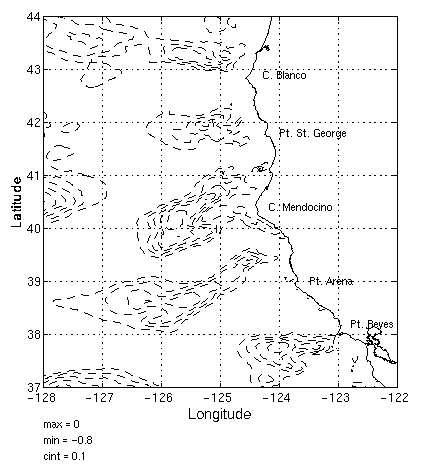
Coastal Upwelling Dynamics
Abstract:
Coastal upwelling and cross-shelf exchange are important
dynamical processes in coastal oceans for considering the
marine biogeochemical cycling of carbon and nitrogen.
One of the most important unresolved issues in coastal physical
oceanography is how shallow-water, near-shore currents
interact dynamically and exchange material properties
with adjacent deep-water currents across the continental shelf
and lope. Our studies focus on the joint effects of topography and
atmospheric forcing on the upwelling processes, such as the formation of
recurrent upwelling centers off New Jersey (Glenn et al. 1996)
and the cold filaments in the coastal regions
off the West Coast of the United States (e.g., Figure 1)
Both theoretical method (Song et al. 2001a; Song and Chao 2002)
and modeling approach (Song et al. 2001b) have been used.
These recent studies reveal that the alongshore-varying
topography plays an important role in causing the meandering
upwelling fronts to break and form cold filaments.
For example, five cross-shore transport jets are determined along
the northern California region (Figure 2) and each carries 5 to
15 Sv of coastal water offshore. Such kinds of jets have
important implications for estimating coastal fluxes in global
biogeochemical studies. Future study will focus on assessing
the impact of the time-space variability of local and remote
forcing on the formation of coastal upwelling and frontal variability.

Figure 1:
Satellite image of SST shows multiple upwelling centers and cold
filaments off central California (Courtesy of E. Armstrong).

Figure 2:
Model results showing multiple cross-shore transport jets off the
US West coast (Song et al., 2001)
Reference:
Glenn, S., M. Crowley, D. Haidvogel, and Y. T. Song, 1996: Underwater observatory captures coastal upwelling
events off New Jersey, EOS Trans. Amer. Geophys. Union, 77, 233, 236.
Song, Y. T., D. Haidvogel, and S. Glenn, 2001a:
The effects of topographic variability on the formation
of upwelling centers off New Jersey: A theoretical model, J. Geophys. Res. 106, 9223-9240.
Song, Y. T., and Y. Chao, 2002: The role of topography in coastal upwelling
and cross-shore exchange: A theoretical study, Ocean Modeling, submitted.
Song, Y. T., Y. Chao, P. Marchesiello, and J. C. McWilliams, 2001b: The role of topography in coastal upwelling and cross-shore exchange: A computational study, J. Phys. Oceanogr., revised.
|




